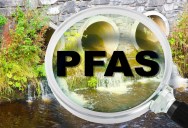Study Finds Most Of Earth’s Water Is Contaminated By “Forever Chemicals”

We’ve seen study after study prove that microplastics are absolutely everywhere, from the air we breath to the amniotic fluid we float in before we’re born.
No one figures they’re particularly good for us, but there haven’t been many (or any) studies that prove exactly what negative impacts they’re having.
On the other hand, toxic “forever chemicals” are known to cause a whole host of problems in the human body, from cancer to impaired kidney and thyroid function.
So, you can imagine that learning most of our water is contaminated wouldn’t be great news.

The water in question is the globe’s source water, which has not yet been treated for drinking.
“Forever chemicals” are per- and poly-fluoroalkyl substances (PFAS). They have been in use since the 1950s and are present in over 14,000 human-made chemicals that have been used in coatings and products that are resistant to stains, heat, oil, grease, and water.
They can be found in pots, pans, clothing, furniture, adhesives, food packaging, cooking surfaces, insulation, firefighting foams, and even paper straws.
Studies have found links between exposure to PFAS and the development of adverse health and environmental outcomes like altered metabolism, altered s*x hormone levels, liver, kidney, and testicular cancers just to name a few.
The world has started tightening restrictions on the use of PFAS, but it’s safe to say the scale we’ve been using them on has already wrought extensive damage to the world around us. This international study led by researchers at the University of New South Wales Sydney has found that the amount of PFAS in global source water exceeds safe drinking limits.

Senior study author Professor Denis O’Carroll issued a statement.
“We already knew that PFAS is pervasive in the environment, but I was surprised to find out the large fraction of source waters that are above drinking water advisory recommendations. We’re talking about 5 percent, and it goes over 50 percent in some cases.”
To compile this report, they used government reports, databases, and peer-reviewed literature from across the world – 45,000 data points in total, spanning 20 years.
O’Carroll does make the distinction that these traces were found in source water, not drinking water, which goes through treatment plants that purify water for consumption.
Some facilities are equipped to reduce the amount of chemicals in the water before pumping it out to homes.
Not all, though.
“Drinking water is largely safe, and I don’t hesitate drinking it. I also don’t suggest bottled water is better, because it doesn’t mean that they’ve done anything differently than what comes out of the tap.”
The study also found higher concentrations where firefighting foams had been used in the past, especially military institutions and fire training facilities.
“These chemicals are regulated to different extents around the world. In the US, proposed drinking water limits for PFOS and PFOA are four nanograms per litre.”
Australia regulates a third chemical, PFHxS, as does Canada. None of the three countries agree on a limit, however.

According to the study, 69% of the samples exceeded Canada’s safe drinking water limits, but only 32% of the same samples exceeded the US’s drinking water hazard index.
“There’s a real unknown amount of PFAS that we’re not measuring in the environment. Commercial products like garments and food packaging have a lot more PFAS in them than we realize. This means we’re likely underestimating the environmental burden posed by PFAS.”
The researchers are looking to quantify the levels of PFAS created by commercial products and their presence in the environment.
I’d say we’d all be grateful. But only if we can get our governments on board to make big changes when we get the results.
If you found that story interesting, learn more about why people often wake up around 3 AM and keep doing it for life.

Sign up to get our BEST stories of the week straight to your inbox.




